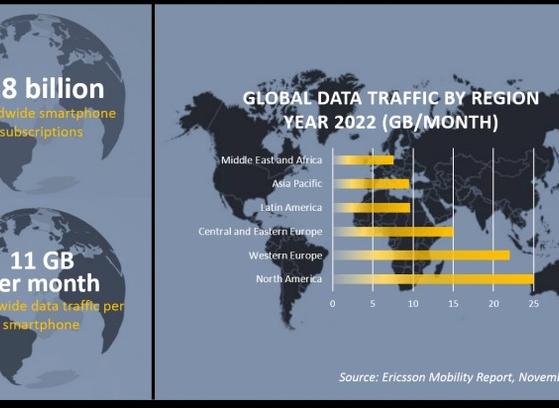At this year's 5G Asia, September 26-28, Infosista's Technical Sales Manager, Muhannad Al-Abweh, will be discussing the importance of testing mobile video services. As Muhannad prepares for his travels to Singapore, we thought we'd go ahead and help set the stage for his presentation. But this is no excuse for you to not plan on attending the panel discussion he will participate in on September 27th, titled Mobile Video Services on the Path to 5G at 12:45.
By now, most of us in the industry have been made aware of the growing trend toward mobile video, and the increasing demand it is expected to continue to have on mobile networks. According to Ericsson's report on mobile traffic (2016), “data traffic grew 60% between Q1 2015 and Q1 2016,” with that increase in mobile data traffic being “fueled primarily by more viewing of video content ” (2016). Mobile video traffic alone, as Ericsson's report points out, “is forecast to grow by around 55 percent annually through 2021, when it should account for over two-thirds of all mobile data traffic” (2016). YouTube is still the dominant force behind mobile video, while Netflix is next in line (Ericsson, 2016). And according to a report by Ooyala, “smartphones are now host to 43% of all video views, up 10% from the second quarter of 2015, and tablets are responsible for 8% of all digital video views, up 51% year over year” (Tribbey, 2016).
 Viewing pictures on the mobile device. Hi-res digitally generated image.
Viewing pictures on the mobile device. Hi-res digitally generated image.
Mobile video includes watching movies, TV shows, sports, and social media videos, and just 30 minutes a day watching streaming video by one person with a smartphone can result in 5GB of data usage (Verizon Wireless, 2016). When this scenario is multiplied by the number of consumers on a network also watching streaming video (in addition to other data intensive apps that are being used), a huge demand on network capacity occurs resulting in a poor mobile video experience for many of those consumers. This poor mobile video experience can involve poor resolution issues or stalling that can last seconds to minutes (Citrix, 2013). When consumers experience issues with mobile video quality, some get frustrated and lose interest, which “lowers video consumption and eventually increases churn” (Citrix, 2013). For this reason, mobile network operators (MNOs) have begun initiatives to enhance the quality of their networks in order to support the best video quality of experience (QoE) for their customers (Burger, 2016).
The demand for better mobile video QoE is no doubt on the rise, and the corresponding demand on MNOs to ensure their networks can deliver a reliable and consistent mobile video QoE must follow suit, especially with new advancements in mobile video launching today and tomorrow. And things are just starting to warm up. Facebook has already been enabling video content to play automatically, and will soon have “news feed videos, ads and live broadcasts...autoplay in a 2:3 aspect ratio rather than the square 1:1 format” (BI Intelligence, 2016). Apple Inc. and Google recently made tweaks to their mobile web browsers “to enable video content to play automatically in web pages, provided audio is muted” (Marshall, 2016). This move by Apple and Google (and other media platform companies with similar moves in the works) will likely lead to even higher mobile data consumption, resulting in challenges for MNOs occurring sooner than expected. And this is just the beginning of some of the possible advances to come. Tomorrow's mobile video experience will likely be much different from what we experience today. Some say that “immersion is the next frontier in mobile video,” where consumers will feel like they are actually participating in the video content via teleportation. (Wadhera, 2016).
As MNOs focus today on expanding and optimizing their networks to support a better mobile video experience for their customers, they must do so by regularly testing and monitoring their networks for such QoE metrics as codec, resolution, bit rate, packet loss, jitter, and throughput. However, as networks evolve to 5G, network testing will also evolve. At this year's 5G Asia, September 26-28, Infovista's Technical Sales Manager, Muhannad Al-Abweh, will be covering in technical detail how MNOs can measure the mobile video QoE today and on the path to 5G.
Sources
- BI Intelligence (2016). Facebook's mobile update embraces vertical video. Retrieved from http://www.businessinsider.com/facebooks-mobile-update-embraces-vertical-video-2016-8
- Burger, A. (2016). T-Mobile Binge On may have found a mobile video sweet spot. Retrieved from http://www.telecompetitor.com/t-mobile-binge-on-may-have-found-a-mobile-video-sweet-spot/
- Citrix (2013). Quality of experience for mobile data networks. Retrieved from https://www.citrix.com/content/dam/citrix/en_us/documents/products-solutions/quality-of-experience-for-mobile-data-networks.pdf
- Ericcson. (2016). Mobile traffic. Retrieved from https://www.ericsson.com/mobility-report/mobile-traffic
- Marshall, J. (2016). Apple and Google browser tweaks could boost mobile video. Retrieved from http://www.wsj.com/articles/apple-and-google-browser-tweaks-could-boost-mobile-video-1474452060
- Tribbey, C. (2016). Ooyala: Mobile accounting for half of video viewing. Retrieved from http://www.broadcastingcable.com/news/technology/ooyala-mobile-accounting-half-video-viewing/159779
- Verizon Wireless (2016). Data calculator. Retrieved from https://www.verizonwireless.com/b2c/splash/dataShareCalculator.jsp
- Wadhera, M. (2016). The future of mobile video is virtual reality. Retrieved from https://techcrunch.com/2016/08/30/the-future-of-mobile-video-is-virtual-reality/










